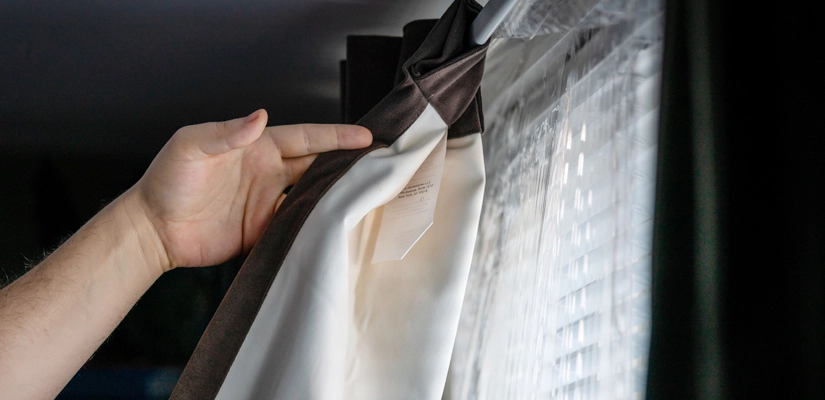
Glass Doctor recommends installing thermal curtains for winter to boost home comfort and energy efficiency.
|
Your curtains aren't just for privacy– in the winter they can also keep rooms warm, lower energy bills and reduce interior window condensation; but only if they're thermal curtains!
Read on to learn everything you need to know about selecting thermal curtains for your home:
What Are Thermal Curtains?
A thermal curtain is a curtain, or drape, made of thick insulating material that's sandwiched between two or more layers of fabric: one that faces the inside of your home and is decorative and another that faces the window that serves as a vapor barrier. The thick, insulating material in the middle is most often made of high-density foam that minimizes thermal exchange.
Homeowners usually hang thermal curtains in the winter to decrease heat loss from windows and sliding glass doors. But due to their insulating properties, they're also a boon in the summer months when they help air-conditioned rooms stay cool.
How to Choose Thermal Curtains for Your Home
Today's homeowners have a wide selection of thermal curtains to choose from, including all sorts of designs from patterned to textured, and coming in every color under the sun. We guarantee there's a thermal curtain to match your décor.
When choosing thermal curtains, remember:
- Selecting the right size curtain matters.
Thermal curtains that are too small will not provide the same insulating benefits. Be sure to carefully measure your windows and sliding doors first. - Keep curtains close to the window.
Choose a curtain rod that will keep the curtain close to the window for maximum energy savings. Curtains that that hang close to the window offer better insulation than those that hang far from the window. - Single-layer curtains don't get the job done.
Some manufacturers now offer a single-layer thermal curtain made of one singular layer of insulating material. In our experience, homeowners will see better energy efficiency results from curtains made of multiple layers of material. - Thermal curtains are an investment.
In most cases, thermal curtains will be more expensive than their standard counterparts. But thermal-lined curtains will help to reduce energy costs for your household. An investment in energy efficient curtains now pays off for years to come. - Thermal curtains are for sliding doors, too.
Drafty patio door letting in all kinds of cold every winter? An appropriately sized thermal insulating curtain will make a difference in both comfort and energy savings. - Floor-to-ceiling panels and pelmets provide additional efficiency.
Thermal curtains that go the height of your interior, stretching from floor to ceiling, will more efficiently insulate than curtains cut to the height of the window. Additionally, adding a pelmet, a fitted piece of wood or cloth, to the top of the curtain will further improve your curtain's energy efficiency. - Choose the curtain that's right for you.
Some thermal-lined curtains come with blackout fabric backing that reduces glare from sunlight, headlights, streetlights or other exterior light. Other designs are thick enough to muffle noise pollution and quiet your home or apartment. Consider all your options and pick thermal curtains that's right for both your needs and your sense of style.
DIY Thermal Curtains
Prefer to sew your own curtains? Made with care, DIY thermal curtains can be as effective as their professionally manufactured counterparts.
To create your own thermal curtains, you'll need:
- Decorative fabric with a tight weave (this is the fabric you'll see from the interior of your home).
- A water-wicking fabric that can serve as a vapor barrier (for use on the window-facing side).
- Thick batting with insulating properties (to insulate the curtain).
- Grommets
- Additional fabric and batting to create a pelmet.
Directions for Sewing DIY Thermal Curtains
- Carefully measure your curtain. Remember, the curtain must fully cover the window or door. To be most effective, cut your fabric panels long enough to hang floor to ceiling.
- Cut the decorative fabric, the water-wicking fabric and the batting to match your measurements. Leave additional fabric at the top of both fabrics for the installation of grommets.
- Install grommets according to grommet manufacturer's recommendations.
- Take the two pieces of fabric (interior and exterior) and flip them inside out. Sew seams along three curtain edges.
- Turn the fabric pouch (the two pieces of fabric now sewn together) right side out and stuff with batting.
- Sew the fourth and final side of the curtain pouch, now stuffed with batting, shut.
- Hang your new curtain along a curtain rod that's fitted tightly against the window or door.
- Use additional fabric (either fabric will work) and batting to create a pelmet.
Increase Your Home's Energy Efficiency with Window Repair or Replacement
Even the highest quality insulated curtains won't completely mitigate the effects of broken window seals, single pane windows or ageing window frames. At Glass Doctor, we specialize in repairing and replacing windows to increase your home's efficiency and decrease energy bills.
Ready to explore your window replacement and repair options? Schedule an appointment online or contact your local Glass Doctor for a consultation.

